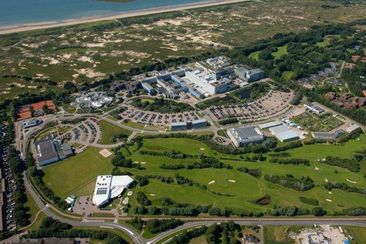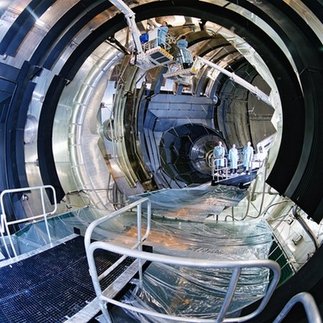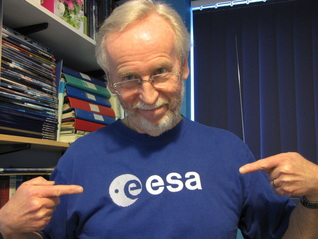 Aerial view of ESA Estec, Noorwijk, The Netherlands
Aerial view of ESA Estec, Noorwijk, The Netherlands mention in the book – How Spacecraft
Fly – I have been visiting Estec several times a year over the last 30 years or so, during my working life in both industry and academia.
In fact the first thing I did when I joined the University of Southampton in 1987 was to lecture on the first Space Systems Engineering short course, run by the University on site in Holland.
Subsequently in 1990 I took on the management and organisation (as well as lecturing of course) of the ESA short course programme until my retirement in 2010. However, I still do the odd few days lecturing for the University at Estec, and that’s because it’s fun and because they pay me well! As my wife Marion is fond of saying – ‘old academics never die, they just loose their faculties’! Not sure if that joke translates into other languages …?
observatories (such as ISO, XMM Newton, Planck, Herschel and Gaia) or robotic planetary explorers (such as Magellan, Cassini-Huygens, Rosetta and Bepi Colombo). If you are not familiar with these projects, then google them. Clearly there are lot of spacecraft in their in-flight phase, and these are controlled and operated by the ESA team at the European Space Operations Centre (ESOC) in Darmstadt, Germany. But then there are many spacecraft in the build and test phase, and others at the proposal phase. Estec staff spend a significant proportion of their working life interfacing with, and monitoring industry, particularly when spacecraft are
being designed, manufactured, assembled and tested. Obviously there is a lot of commercial space activity going on in Europe (mostly in the area of space communications), and ESA often does not have a direct involvement in this, although a lot of European space technology has ‘spun-out’ from ESA projects into the commercial sector.
The Agency operates a system of ‘juste retour’ in its dealings with European industry. In other words, each member state pays in a monetary contribution to the Agency and then receives, in return, work to its industry in proportion to its contribution. So the more you pay in, the more work you get back. For most member states, with a well developed and capable space industry, this arrangement works well. But sometimes the politics of juste retour can be problematic for member states with industrial capabilities which are not so well developed.
Then the politics can lead to situations where highly specialised tasks can be assigned to companies which are ill-equipped to cope with them. Clearly this is an unusual circumstance, but the policy does sometimes create problems which need to be handled sensitively. Historically, one of the reasons why Estec is located in the Netherlands is that at the time it was established (1968), there was a mismatch between the Netherland’s
contribution to the agency, and the size of the country’s space industry – at the time Holland’s space industry was too small to sustain the level of work returned under the policy. So ESA’s technical HQ was sited in the Netherlands in compensation.
 The LSS - ESA Estec Test Centre
The LSS - ESA Estec Test Centre this way is a very enlightened (and rare) training strategy, helping the support staff to understand more thoroughly the business in which they are involved. On this visit I also had the opportunity to visit the Estec Test Centre, which has the largest and most impressive test facilities in Europe. These facilities include:
- TheLarge Space Simulator (LSS). This is a very large chamber (see picture) which simulates the vacuum and
cold of space, as well as the heat of the Sun.
- Various shakers to emulate the vibration and shock of the launch vehicle on its ‘rough ride’ to orbit – the largest shaker takes hardware up to 10 tonnes in mass.
- Chambers in which the communications capabilities of spacecraft are tested.
- The Large European Acoustic Facility (LEAF). This is basically a bunker in which the unimaginably intense acoustic field of the launch vehicle is reproduced, to determine whether a spacecraft can endure this without causing damage.
 The author wearing his ESA fan T shirt!
The author wearing his ESA fan T shirt! system, which is an enhanced version of the US Navstar GPS.
Finally, having said all that, I do wonder how many of the
projects that I have mentioned are familiar to you? Over the years ESA has done amazing things – for example, soft landing a probe on Titan (the largest moon of Saturn)and orbiting an observatory with the largest aperture. Now we have the promise of the Rosetta project, the goal of which is to rendezvous with, and land on a comet during the coming year. Although I am a great fan of ESA, one issue that I have is that they are generally poor at public relations. When NASA achieves some great feat of space engineering or science, everybody knows about it. However, when you look at ESA’s amazing record of achievements, who knows about them? Come on ESA! Wake up ‘blow your own trumpet’ – very loudly!
 RSS Feed
RSS Feed
